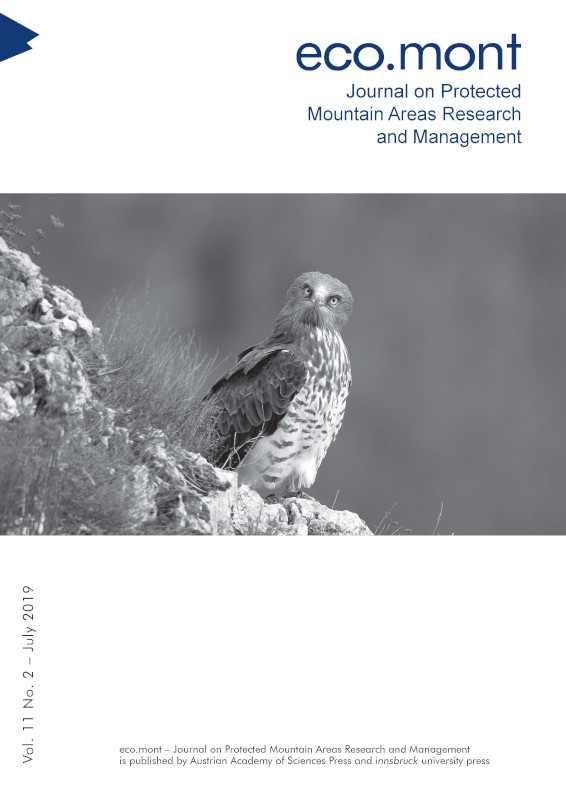Valerie Braun – Martin Coy – Günter Köck (Eds.)
eco.mont
Journal on Protected Mountain Areas Research and Management
Dominika Cywicka,
Magdalena Hędrzak,
Mirosława Długosz,
Luiza Tymińska-Czabańska
S. 4 - 10
doi:
10.1553/eco.mont-11-2s4
Verlag der Österreichischen Akademie der Wissenschaften
doi:
10.1553/eco.mont-11-2s4
Abstract:
Managing large ungulates in the territory of national parks requires comprehensive knowledge of many factors (population parameters, the distribution of animals and the number of their habitats, their feeding grounds, the intensity and direction of their migration), and skill in responding to the effects of negative chance events. A large number of the factors are by nature stochastic; thus, from a programming perspective, the issue of managing ungulate populations is difficult to formulate as an algorithm. This paper presents a model built using artificial neural networks (ANN). The results obtained with this model show that it is possible to maintain the population in a park without the necessity for culling within its boundaries. The study also demonstrated that culling specifically of hinds in these areas should be increased. The research presents alternative culling strategies for red deer populations in protected areas.
natural regulation, Cervus elsphus, hunting, protected area, artificial neural network
Published Online:
2019/07/01 12:40:01
Document Date:
2019/07/01 12:18:00
Object Identifier:
0xc1aa5576 0x003abf02
Rights:https://creativecommons.org/licenses/by-nc-nd/4.0/
The journal “eco.mont” – Journal of protected mountain areas research and management – was published for the first time in June 2009.
The journal was founded as a joint initiative of the Alpine Network of Protected Areas (ALPARC), the International Scientific Committee on Research in the Alps (ISCAR), the Austrian Academy of Sciences (ÖAW) and the University of Innsbruck.
The journal aims to highlight research on and management issues in protected areas in the Alps without excluding other protected mountain areas in Europe or overseas. Its target audiences are scientists from all related disciplines, managers of protected areas and interested individuals including practitioners, visitors, teachers, etc.
The journal presents peer-reviewed articles in English by authors who research protected mountain areas and management issues within these areas. It's published twice a year as a collaboration of the Austrian Academy of Sciences Press – responsible for the e-version – and Innsbruck University Press – responsible for the print version.
Die Zeitschrift „eco.mont“ – Zeitschrift zur Forschung in Gebirgsschutzgebieten – erschien im Juni 2009 zum ersten Mal. Die Zeitschrift wurde auf Initiative des Netzwerks Alpiner Schutzgebiete (ALPARC), der Schweizer Akademie der Naturwissenschaften (ISCAR), der Österreichischen Akademie der Wissenschaften (ÖAW) und der Universität Innsbruck gegründet. Sie hat das Ziel, Themen zu behandeln, die gleichzeitig Forschung und Verwaltung in und über die Schutzgebiete der Alpen betreffen, ohne dabei andere Gebirgsschutzgebiete Europas oder anderswo auszuschließen. Diese neue Zeitschrift richtet sich an ein Publikum von Wissenschaftlern der verschiedensten Fachbereiche, an die Verwalter von Schutzgebieten und an alle sonstigen Interessierten, Praktiker, Besucher, Lehrpersonal etc. einbegriffen. Die Zeitschrift veröffentlicht begutachtete Beiträge auf Englisch von Autoren, die Fragen der Gebirgsschutzgebiete und deren Verwaltung betreffen. Sie erscheint zweimal pro Jahr, auf der Basis der gemeinsamen Anstrengungen des Verlags der Österreichischen Akademie der Wissenschaften, der für die digitale Fassung verantwortlich ist, und der Presse der Universität Innsbruck, verantwortlich für die gedruckte Fassung.



 Home
Home Print
Print
 References
References
 Share
Share

